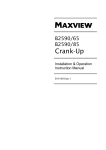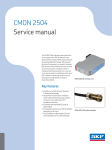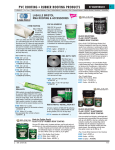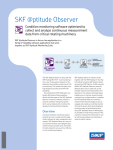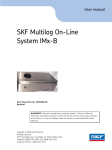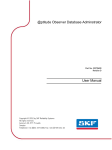Download CM5115 EN CMSS-ONL-2504 and CMON 2504
Transcript
Installation Guide CMON 2504 Acoustic Emission (AE) Interface Card for the SKF Multilog On-line System IMx Introduction This document describes the installation of the CMON 2504 DIN card and the CMSS-ONL-2504 cable assembly into an SKF Multilog On-line System IMx. Requirements The following tools are required to install the CMON 2504 and CMSS-ONL-2504 into the IMx: • • • • J2 J3 Fig. 1. Top view of CMON 2504. wire cutters wire strippers 4 mm crosshead screwdriver 4 mm flat blade screwdriver CMON 2504 The base of the CMON 2504 is identified by the sliding metal clip on the lower end of the enclosure at the rear of the module. Connectors J2 and J3 on top of the unit provide power in and signal output. J1 on the bottom of the unit provides signal input. J1 Fig. 2. Bottom view of CMON 2504. CMON 2504 terminal block connections • J1-1: AE sensor signal / phantom power line (Input +) • J1-2: AE sensor 0 V return (Input –) • J1-3: not used • J2-1: +12 to +24 V DC power supply input (Supply +) • J2-2: 0 V DC power supply input and signal ground (Supply –) • J2-3: not used • J3-1: AE DIN interface demodulated output (Output +) • J3-2: not used • J3-3: Signal ground (Output –) It may be convenient to connect the wires before mounting the CMON 2504 on the DIN rail. Fig. 3. Input signal connections from CMSS-ONL-2504 cable to CMON 2504 J1 (card not yet fitted to DIN rail). CMSS-ONL-2504 The cable will have been pre-stripped to 125 mm, to aid the installation process. CMSS-ONL-2504 wires • Blue and green for AE signals • Red and black for ICP signals The drain wires from the two shields are twisted together and may be connected to the IMx ground rail, if required. IMx-S Single module AE sensor signal connections • Route the signal cable through a port on the enclosure base • Connect the blue wire from the sensor cable to CMON 2504 J1-1 • Connect the green wire from the sensor cable to CMON 2504 J1-2 ICP signal connections Output signal connections • Make a blue/green twisted pair cable (this may be made from excess wire cut off during the AE sensor signal connection) • Connect a blue wire of the output twisted pair to CMON 2504 J3-1 • Connect the green wire of the output twisted pair to CMON 2504 J3-3 • Route the twisted pair to the desired input channel of the IMx • Blue (signal) should be connected to IMx channel terminal A [+] • Green (ground) should be connected to IMx channel terminal B [–] Power connections • Make a black/red twisted pair cable • Connect the red wire from the IMx channel terminal PWR (+24 V) to J2-1 • Connect the black wire from the IMx channel terminal B (0 V) output to J2-2. This is the same terminal that the green wire has already been connected to. • Connect a wire from J3-3 to IMx-S chassis ground. • Connect the cable screen to IMx chassis ground bar Fit the CMON 2504 DIN card to the DIN rail, with the metal clip at the bottom. • The black and red wires coming from the sensor cable are standard ICP signals and can be connected to the standard IMx channel • Red (signal) should be connected to IMx channel terminal A [+] • Black (ground) should be connected to IMx channel terminal B [–] Terminal A or B refers to IMx-S Terminal + or - refers to IMx -W The cable screen is connected to the body of the sensor and is usually grounded by the sensor. Note that where the sensor is glued into position there may not be an electrical connection and the cable screen should be connected to the earth strip below the DIN rail. Fig. 4. ICP signal connections from CMSS-ONL-2504 cable to IMx-S Ch1. 2 Multiple modules Multiple cards As each IMx-S channel has +24 V available, multiple CMON 2504 DIN cards are connected in the same way as a single card, each connected to two channels (one each for the AE signals and the vibration signals). Each +12 V relay output can be used to power up to two CMON 2504 DIN cards, meaning that a maximum of four units can be fitted in the IMx-W without the need for a discrete DIN power supply. • Connect the power to the four cards as shown in fig. 5 IMx-W Single cards AE sensor signal connections • Route the signal cable through a port on the enclosure base • Connect the blue wire from the sensor cable to CMON 2504 J1-1 • Connect the green wire from the sensor cable to CMON 2504 J1-2 ICP signal connections • The black and red wires coming from the sensor cable are standard ICP signals and can be connected to standard IMx channel • Red (signal) should be connected to IMx channel terminal A [+] • Black (ground) should be connected to IMx channel terminal B [–] The cable screen is connected to the body of the sensor and is usually grounded by the sensor. Where the sensor is glued into position there may not be an electrical connection and the cable screen may need to be connected to the earth strip below the DIN rail. Output signal connections • Make a blue/green twisted pair cable (this may be made from excess wire cut off during the AE sensor signal connection) • Connect a blue wire of the output twisted pair to CMON 2504 J3-1 • Connect the green wire of the output twisted pair to CMON 2504 J3-3 • Route the twisted pair to the desired input channel of the IMx • Blue (signal) should be connected to IMx channel terminal A [+] • Green (ground) should be connected to IMx channel terminal B [–] Power connections • Make a black/red twisted pair cable • Connect the red +24 V wire from the IMx relay driver CH1 +12 V to CMON 2504 J2-1 • Connect the black 0 V wire from the IMx CAN bus GND to CMON 2504 J2-2 • Connect a wire from J3-3 to IMx-W chassis ground • Connect the cable screen to IMx chassis ground bar Fit the CMON 2504 DIN card to the DIN rail, with the metal clip at the bottom. Fig. 5. Power connection for four CMON 2504 DIN cards fitted in IMx-W. Configuration In order to configure IMx-S, IMx-T or IMx-M and SKF @ptitude Analyst / SKF @ptitude Observer, it is necessary to position DIP switches in the used channels as shown in figs. 6 and 7. Changes to DIP settings should only be made when the IMx unit is powered off. Terminal DIP Settings position: 123456 + A – B 100100 Fig. 6. DIP switch positions for IMx-S, IMx-T and IMx-M channels 1-8. Terminal N.C. P + A – B Shield S DIP A Settings DIP B Settings 100100 0010 Fig. 7. DIP switch positions for IMx-M channels 9-16. 3 Installation considerations IMx-S Sensor mounting gE AEE 100110 100100 Ch1 P In most cases, the AE sensor is mounted on a bearing housing or a machine casing. Hence, the material of the casing and the distance between the source and the sensor can have a significant effect on the attenuation of the AE wave. It is vital that the surface onto which the sensor is to be mounted must be free of paint, coatings or rust, have a smooth machine finish and have a suitable AE couplant between the sensor and the surface. Chx Ch2 B P A A P B Chx A B P Chx A x B P Chx A B P Chx A B P A Chx B P A Chx B P A Chx B P A Chx B P A B x J3-3 J3-2 J3-1 J2-3 J2-2 J2-1 J3 J2 CMON 2504 J1 Red Black Blue x Green Cable screen The right choice of couplant and adhesives between the interfaces are vital in order to avoid attenuation of AE. It is important to remove all traces of air between the mating surfaces (even smooth ones) by means of a couplant with an AE impedance matched closely to steel, and with the ability to last for the required period of time required for that application. Chassis ground bar To CMSS 786M sensor Fig. 8. CMON 2504 wiring diagram – IMx-S. IMx-W Stud method gE Ch1 + Relay driver AEE Ch2 - + - Chx + Chx + - + x Chx + - Chx - + Chx - + Chx - + Chx - + Ch1 - Ch2 D0 +12V D0 +12V CAN H CAN L CAN RS485 GND CAN A B GND x J2-3 J2-2 J2-1 J3 J2 CMON 2504 Table 1 J1 Stud method specifications Red To Surface preparation toolkit Black Blue J1-3 J1-2 J1-1 From Chx - J3-3 J3-2 J3-1 The stud method provides the best results with least attenuation of the AE. It also has the benefit of having only one interface and not requiring any adhesive. The mating surface on the bearing or machine housing should be prepared in accordance with the specifications provided in the following table. Stud model J1-3 J1-2 J1-1 Choice of couplant and adhesives x Green Cable screen CMSS 30168700 CMSS 30168701 CMSS 30168703 1/4-28 1/4-28 1/4-28 1/4-28 M8 M6 CMAC 9600-01 CMAC 9600-02 CMAC 9600-10 Chassis ground bar To CMSS 786M sensor Fig. 9. CMON 2504 wiring diagram – IMx-W. In cases where it is not possible to drill and tap a hole to allow the stud method to be used, the sensor glue mount that is included with the cable assembly should be used. It should be fixed to the mounting surface using a thin layer of Loctite 480 adhesive. The use of other adhesives or sensor mounts can significantly attenuate the AE signal. For a small number of applications which utilise an “insulated bearing” design, it is preferable to also use an insulated “adhesive mounting pad” method by adhering a CMSS 910MI cementing stud with 1/4”-28 male to the surface of the bearing or machine housing and then use a suitable couplant (e.g., Geocel Marine Silicone) between it and the AE sensor. This isolated mounting stud allows the sensor to be isolated from the bearing thus preventing any potential ground loops. 4 SKF CMON 2504 Installation Validation It is recommended that installations of the CMON 2504 be validated before they are commissioned. All installations of the CMON 2504 must be validated using a digital voltmeter. Furthermore, it is recommended that in addition to using a digital voltmeter, the entire AEE installation should be validated using the SKF CMAC 2504 acoustic emission pulse generator to inject a known signal into the installation site and SKF @ptitude Observer / SKF @ptitude Analyst to inspect the system response. 1, CMON 2504 Installation Validation Use the digital voltmeter and the provided flow chart († fig. 12) to perform initial validation of the CMON 2504 installation. If the CMON 2504 installation is found to be OK, then you can proceed to testing the AEE system installation. 2. AEE System Validation The CMAC 2504 is used to inject a known signal into the bearing. The system response to the signal is used to validate the entire installation. The CMAC 2504 generates a pulse train output with 20 V amplitude, 2.0 us pulse width, and a repetition frequency of ~70 Hz. To inject a signal, acoustic emission couplant is applied to the acoustic emission transducer, the transducer is connected to the CMAC 2504 and the device is turned on. The transducer is then placed on the test surface (AE sensor or adjacent to AE sensor installation site). Before testing with the CMAC 2504, ensure that the AE sensor is connected to a CMON 2504 card, which should in turn be connected to an IMx. SKF @ptitude Observer / @ptitude Analyst should also be preconfigured to acquire acoustic emission signals. Testing the system using the CMAC 2504 is recommended in two steps: 1 Use the CMAC 2504 to inject a signal directly into the AE sensor before installing the sensor. 2 Then assured that the system is working, install the AE sensor and then use the CMC 2504 transducer to inject the signal onto the same flat metallic surface the AE sensor is installed on, ensuring it is free of paint or residue. Ensure there is a direct transmittance path between the CMAC 2504 transducer and the AE sensor (e.g., no cracks, joints, nuts, bolts, etc., interrupting the path). The system response for both steps should be viewed in SKF @ptitude Observer (“live” mode is recommended). The system response should be an attenuated pulse train with the same repetition frequency (~70 Hz). If the system response is not as expected, check the following: • The AE sensor is fixed and secured on its installation site • There is acoustic emission couplant on both the AE sensor and the CMAC 2504 transducer • There are no cracks, joints, nuts or bolts interrupting the transmittance path between CMAC 2504 transducer and AE sensor • The cable is connected to the AE sensor • If none of the above resolve the issue, repeat testing using the digital voltmeter • Refer to the CMAC 2504 user manual for further details Fig. 10. The SKF CMAC 2504 and acoustic emission transducer. Fig. 11. Response of a correctly functioning AEE system to the CMAC 2504 input. Note the clear pulse train in the time domain, which corresponds with ~70 Hz in the spectrum. 5 1. Check CMON 2504 Power Supply Measure voltage across J2-1 and J22 >11V < 11V Low Power Power OK 2. Check CMON 2504 input IMx-W Check power supply External supply IMx-S >6.9V & <7.1 Measure voltage across J1-1 and J12 >7.1V Check wiring Check wiring and IMx DIP settings <6.9V Sensor & cable OK Check cable polarity Polarity OK Cable fault Polarity wrong Correct the polarity 3. Check CMON 2504 output <0.1V Measure voltage across J3-1 and J33 CMON 2504 OK >0.1V CMON 2504 fault / bad power ground Proceed to CMAC 2504 testing Fig. 12. CMON 2504 installation validation flow chart. Please contact: SKF Condition Monitoring Center – Luleå Aurorum 30, SE-977 75 · Luleå, Sweden Tel: +46 (0)31 337 1000 · Fax: +46 (0)920 134 40 Web: www.skf.com/cm ® SKF and MULTILOG are registered trademarks of the SKF Group. Loctite is a registered trademark of Henkel Corporation. All other trademarks are the property of their respective owners. © SKF Group 2014 The contents of this publication are the copyright of the publisher and may not be reproduced (even extracts) unless prior written permission is granted. Every care has been taken to ensure the accuracy of the information contained in this publication but no liability can be accepted for any loss or damage whether direct, indirect or consequential arising out of the use of the information contained herein. SKF reserves the right to alter any part of this publication without prior notice. PUB CM5115/4 EN · May 2014 skf.com Check wiring






